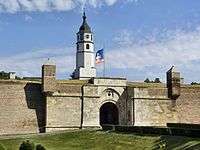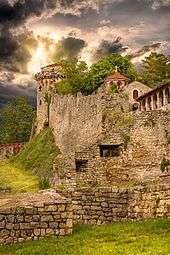Belgrade Fortress
| Belgrade Fortress | |
|---|---|
| Belgrade in Serbia | |
|
Kalemegdan Park, part of the Fortress | |
| Coordinates | 44°49′24″N 020°27′01″E / 44.82333°N 20.45028°ECoordinates: 44°49′24″N 020°27′01″E / 44.82333°N 20.45028°E |
| Type | Fortress |
| Site information | |
| Open to the public | Yes |
| Site history | |
| Built | 535 |
| Built by | Justinian I |
| Materials | Stone |
Belgrade Fortress[1][2] (Serbian: Београдска тврђава / Beogradska tvrđava), consists of the old citadel (Upper and Lower Town) and Kalemegdan Park[3] (Large and Little Kalemegdan) on the confluence of the River Sava and Danube, in an urban area of modern Belgrade, the capital of Serbia. It is located in Belgrade's municipality of Stari Grad. Belgrade Fortress was declared a Monument of Culture of Exceptional Importance in 1979, and is protected by the Republic of Serbia.[2]
Location
Belgrade Fortress is located on top of the 125.5-meter high[4] ending ridge of the Šumadija geological bar. The cliff-like ridge overlooks the Great War Island (Serbian: Veliko ratno ostrvo) and the confluence of the Sava river into the Danube, and makes one of the most beautiful natural lookouts in Belgrade. It borders the neighborhoods of Dorćol (north and north-east), Stari Grad (east) and Kosančićev Venac (Savamala; south). It is encircled by three streets: Boulevard of Vojvoda Bojović, Tadeuša Košćuška, Pariska, and the railway along the riverside.
History
Belgrade Fortress is the core and the oldest section of the urban area of Belgrade. For centuries the city population was concentrated only within the walls of the fortress, and thus the history of the fortress, until most recent times, equals the history of Belgrade itself (see: Timeline of Belgrade history). The first mention of the city is when it was founded in the 3rd century BC as "Singidunum" by the Celtic tribe of Scordisci, who had defeated Thracian and Dacian tribes that previously lived in and around the fort. The city-fortress was later conquered by the Romans, was known as Singidunum and became a part of "the military frontier", where the Roman Empire bordered "barbarian Central Europe". Singidunum was defended by the Roman legion IV Flaviae, which built a fortified camp on a hill at the confluence of the Danube and the Sava rivers. In the period between AD 378 and 441 the Roman camp was repeatedly destroyed in the invasions by the Goths and the Huns. Legend says that Attila's grave lies at the confluence of the Sava and the Danube (under the fortress). In 476 Belgrade again became the borderline between the empires: the Western Roman Empire and Eastern Roman Empire (Byzantine Empire), and the Slav-Avar State in the north.


The Byzantine Emperor Justinian I rebuilt the fortress around 535. In the following centuries the fortress suffered continuous destruction under the Avar sieges. The Slavs (Serbs) and Avars had their "state union" north of Belgrade with the Serbs and other Slavic tribes finally settling in the Belgrade area as well as the regions west and south of Belgrade in the beginning of the 7th century. The name Belgrade (or Beograd in Serbian), which, not just in Serbian but in most Slavic languages, means a "white town" or a "white fortress", was first mentioned in AD 878 by Bulgarians. The fortress kept changing its masters: Bulgaria during three centuries, and then the Byzantines and then again Bulgarians. The fortress remained a Byzantine stronghold until the 12th century when it fell in the hands of the newly emerging Serbian state. It became a border city of the Serbian Kingdom, later Empire with Hungary. The Hungarian king Béla I gave the fortress to Serbia in the 11th century as a wedding gift (his son married the Serbian princess Jelena), but it remained effectively part of Hungary, except for the period 1282–1319. After the Serbian state collapsed after the Battle of Kosovo in 1404, Belgrade was chosen as the capital of the principality of Despot Stefan Lazarević. Major work was done to the ramparts which were encircling a big thriving town. The lower town at the banks of the Danube was the main urban center with a new build Orthodox cathedral. The upper town with its castle was defending the city from inland. Belgrade remained in Serbian hands for almost a century. After the Despot's death in 1427 it had to be returned to Hungary. An attempt by Sultan Mehmed II to conquer the fortress was prevented by Janos Hunyadi in 1456 (Siege of Belgrade), saving Hungary from Ottoman dominion for 70 years.
In 1521, 132 years after the Battle of Kosovo, the fortress, like most parts of the Serbian state, was conquered by the Turks and remained (with short periods of the Austrian and Serbian occupation), under the rule of the Ottoman Empire until the year 1867, when the Turks withdrew from Belgrade and Serbia. During the short period of Austrian rule (1718–1738), the fortress was largely rebuilt and modernized. It witnessed the Great Serbian Migration in the 17th century and two Serbian Uprisings in the 19th century, during the Turkish Period. The fortress suffered further damage during the First and the Second World Wars. After almost two millennia of continuous sieges, battles and conquests, the fortress is today known as the Belgrade Fortress. The present name of Kalemegdan Park derives from two Turkish words, kale (fortress) and meydan (battlefield) (literally, "battlefield fortress").
Overview

With the neighboring residential area, fortress forms one of the local communities (mesna zajednica) within Belgrade, which had a population of 2,676 in 2002.
Belgrade Fortress is generally divided into four sections:
- Donji Grad (Доњи Град or "Lower Town"); occupies the slope towards the riversides, from the top spot (ridge where "The Victor" is). Between the lowest section and the Danube is Kula Nebojša ("Impregnable, Fearless, or Daredevil Tower"), which has been turned into a museum of the Greek revolutionary Rigas Feraios, who was strangled by the Turks in this tower and his corpse thrown into the Danube. Donji Grad, like the neighboring Savamala, frequently suffers from flooding, and Kula Nebojša suffered extensive damage during the major floods of 2006. The Orthodox churches of Ružica (former Austrian gun depot) and Sveta Petka are also located in this area, as is the Belgrade Planetarium.
- Gornji Grad (Горњи Град or "Upper Town"); the upper section of fortress, turned into a park, with beautiful promenades and the statue of "The Victor" (Serbian Pobednik), the so-called "Roman well" (Serbian Rimski bunar), actually built by the Austrians, the Popular Observatory, the türbe (tomb) of Damad Ali Pasha, tennis and basketball courts, etc.
- Mali Kalemegdanski park (Мали Калемегдански парк or "Little Kalemegdan Park"); it occupies the area in the eastern section, which borders the urban section of Belgrade. The northern section of Little Kalemegdan Park is occupied by the Belgrade zoo, opened in 1936. The art pavilion Cvijeta Zuzorić is also located here.
- Veliki Kalemegdanski park (Велики Калемегдански парк or "Large Kalemegdan Park"); it occupies the southern corner of fortress, with geometrical promenades, the Military Museum, the Museum of Forestry and Hunting, and the Monument of Gratitude to France.
Kalemegdan is the most popular park among Belgraders and for many tourists visiting Belgrade because of the park's numerous winding walking paths, shaded benches, picturesque fountains, statues, historical architecture and scenic river views (Sahat kula – the clock tower, Zindan kapija – Zindan gate, etc.). The former canal which was used for city supplying in the Middle Ages is completely covered by earth but the idea of recreating it resurfaced in the early 2000s. Belgrade Fortress is known for its kilometers-long tunnels, underground corridors and catacombs, which are still largely unexplored. In the true sense, fortress is today the green oasis in the Belgrade's urban area.
As a combination of several habitats (parkland with old trees, fortress, landscape view of rivers and forested Veliko Ratno Ostrvo), Kalemegdan may be interesting for overseas tourists-birdwatchers as it provides a snapshot of local bird fauna. It is also important as the resting spot for small passerine birds on migration, before or after crossing the rivers Sava and Danube. Kalemegdan has its own eBird hotspot and associated webpage: http://ebird.org/ebird/hotspot/L1825204?yr=all&m=&rank=mrec&hs_sortBy=taxon_order&hs_o=asc
The Belgrade Race Through History, an annual 6 km footrace, takes place in the park and fortress as a way of highlighting the history and culture of the area.[5]

Concerts
The flat grounds below the fortress have occasionally been used as open-air concert location during late spring and summer:
- 3 September 1997: Partibrejkers
- Belgrade Beer Fest, annually from 2003 until 2007
- 18 June 2011: Amy Winehouse and Moby
- 15 September 2012: Warriors Dance Festival (The Prodigy)
- 24 May 2013: Đorđe Balašević
- 27 May 2013: Green Day (Belgrade Calling Festival, others: Atheist Rap, Superhiks, Hladno Pivo)
- 14 June 2013: Whitesnake
- 22 June 2013: Bajaga i Instruktori
- 17 June 2014: Iron Maiden (Maiden England World Tour, opening act: Ghost)
Furthermore, KK Partizan and Red Star concrete basketball courts on the fortress have been used for concerts:
- 26 June 2009: Simply Red (@KK Partizan court)
- 11 July 2011: MTV Free Concert (@KK Partizan court, Rob Garza from Thievery Corporation, Philippe Cohen Solal from Gotan Project, and Gramophonedzie)
See also
- Monument of Culture of Exceptional Importance
- Gates of Belgrade
- Tourism in Serbia
- Military Museum
- Rose Church
- List of Ottoman military governors of Belgrade Fortress
References
- ↑ A official site of Belgrade Fortress
- 1 2 http://www.kultura.gov.rs/?p=901
- ↑ http://www.beogradskatvrdjava.co.rs/Public-enterprise-_1966-70_1963
- ↑ Statistical Yearbook of Belgrade 2007 - Topography, climate and environment
- ↑ The Belgrade Race Through History Archived February 7, 2009, at the Wayback Machine.. Belgrade Marathon. Retrieved on 2009-10-15.
External links
| Wikimedia Commons has media related to Kalemegdan. |
For more information, visit the official site of Belgrade Fortress
- 3Digital reconstruction of the Belgrade Fortress as it looked in the 15 th century
- A brief history of Belgrade Fortress
- Kalemegdan and the Belgrade fortress
- Kalemegdan images (day and night shots, September 2009)
- The History of Belgrade Fortress

